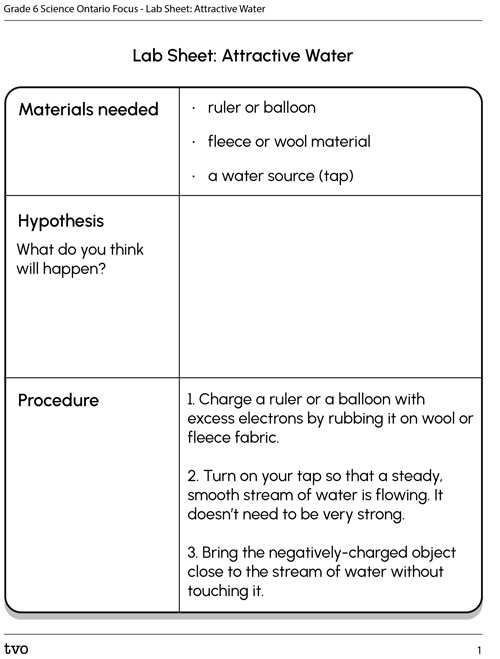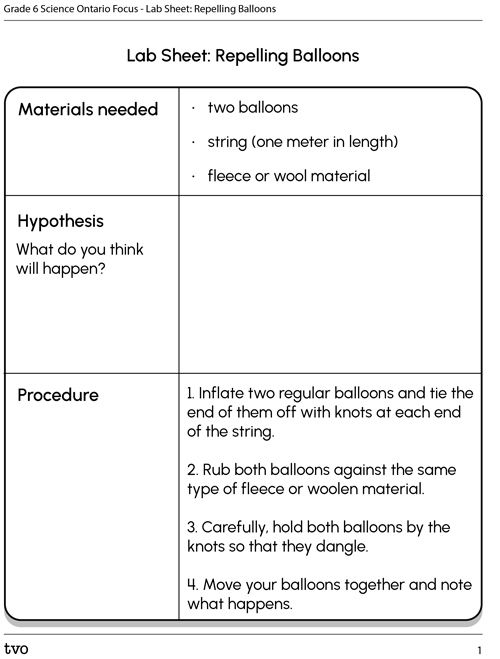Minds On
What is static electricity?

What do you already know about static electricity? What do you wonder?
Complete the Investigating Static Electricity Activity in your notebook or using the following fillable and printable document. If you would like, you can use speech-to-text or audio recording tools to record your thoughts.
|
What I already know about static electricity |
What I wonder about static electricity |
New learning |
|---|---|---|
Press the ‘Activity’ button to access Investigating Static Electricity Activity.
Check out the following video from Science North to learn more about static electricity.
After exploring the video, revisit and add any new information to the New Learning section of your chart.
Action
Part 1: Let’s experiment!

It’s time to experiment! Check out the two following experiments that investigate the principles of static electricity.
Safety
Before you begin:
Hands-on Science
Experiment A: Attractive water
For this experiment, we will be learning about the relationship between static electricity and water.
Complete the Lab Sheet: Attractive Water in your notebook or using the following fillable and printable document. If you would like, you can use speech-to-text or audio recording tools to record your thoughts.

Press the Activity button to access the Lab Sheet: Attractive Water.
Activity (Open PDF in a new tab)Press the following tabs to access the materials and procedure for the Attractive Water experiment.
If you do not have access to materials, access the “Video demonstration” tab to explore the experiment in action. You can use the video to make your observations and draw your conclusions.
You will need:
- ruler or balloon
- fleece or wool material
- a water source (tap)
- Charge a ruler or a balloon with excess electrons by rubbing it on wool or fleece fabric.
- Turn on your tap so that a steady, smooth stream of water is flowing. It doesn’t need to be very strong.
- Bring the negatively-charged object close to the stream of water without touching it.
Check out this video to explore a demonstration of the Attractive Water experiment. Please note that materials and procedure in the video may vary slightly from what is listed in the previous tabs.
Always be sure to do your safety checks before any experiment!
Hands-on Science
Experiment B: Repelling balloons
For this experiment, we will be learning about static electricity and balloons.
Complete the Lab Sheet: Repelling Balloons in your notebook or using the following fillable and printable document. If you would like, you can use speech-to-text or audio recording tools to record your thoughts.

Press the Activity button to access the Lab Sheet: Repelling Balloons.
Activity (Open PDF in a new tab)Press the following tabs to access the materials and procedure for the Repelling Balloons experiment.
If you do not have access to materials, access the “Video demonstration” tab to explore the experiment in action. You can use the video to make your observations and draw your conclusions.
You will need:
- two balloons
- string (one meter in length)
- fleece or wool material
- Inflate two regular balloons and tie the end of them off with knots at each end of the string.
- Rub both balloons against the same type of fleece or woolen material.
- Carefully, hold both balloons by the knots so that they dangle.
- Move your balloons together and note what happens.
Check out this video to explore a demonstration of the Repelling Balloons experiment. Please note that materials and procedure in the video may vary slightly from what is listed in the previous tabs.

Science is about reflecting and reimagining. Was your experiment successful?
Is there anything that you would change about your experiment design to improve it or the outcome?
Even if your experiment was not successful, what did you learn or confirm about the topic you were investigating?
Part 2: Design your own experiment

Consider what you’ve learned from the previous experiments to design your own experiment related to static electricity.
Your goal is to try to move something or pick something up.
Try to use everyday materials that you might have access to in your learning space. Some examples of materials are sugar, pencil shavings, an empty water bottle, or anything else you can think of!
Be sure to follow the scientific experimentation process.
Explore this video to learn more about the steps of the Scientific Experimentation Process.
Science is about reflecting and reimagining.
Is there anything that you would change about your experiment design to improve it or the outcome?
Record your ideas in a notebook or another method of your choice.
Consolidation
Review your learning

For each sentence, select the missing word from the drop-down menu.
Let’s explain!
Consider the design of your own experiment from the Action section.
Create a description or explanation of how static electricity was used to move or pick up the object you chose to use.
Be sure to include the following words:
- electrons
- flow
- static electricity
Record your explanation in a notebook or another method of your choice.
Pause and Reflect
Pause and reflect
Revisit the Investigating Static Electricity Activity from the Minds On section.
Then, reflect and respond to the following questions:
- Were you able to confirm what you already knew?
- Were your questions about static electricity answered?
- What new questions might you add?
- What new learning could you add to the last column?
Record your thoughts in a notebook or another method of your choice.
Reflection
As you read through these descriptions, which sentence best describes how you are feeling about your understanding of this learning activity? Press the button that is beside this sentence.
I feel…
Now, record your ideas using a voice recorder, speech-to-text, or writing tool.